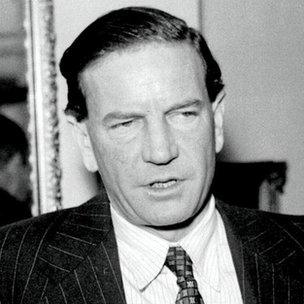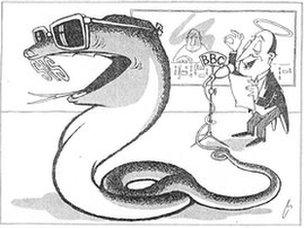The 'secret agents' of the UK press
- Published

Kim Philby may have advised Russia about the use of propaganda
In December 1968 the state-controlled Russian newspaper Izvestia ran a series of articles accusing several high-profile British journalists of being spies - listing their names and alleged codenames.
The articles caused a storm of protest in Britain: the Russians were claiming journalists and editors at the Sunday Times, the Observer, the Daily Telegraph, the Daily Mail and the BBC worked directly with MI6.
The Soviets' evidence for all this? A cache of documents they claimed were MI6 memos, and which looked to have been photographed with a miniature spy camera.
One showed a table listing each publication, the journalist or editor MI6 had as its contact there, their codename and the codename of their MI6 "handler".
Another discussed the procedure for the BBC to broadcast prearranged tunes or sentences that could be used by MI6 officers in the field to prove they were acting on behalf of the British government.
At the time, the claims were dismissed as nonsense by all the newspapers and journalists concerned. The head of the BBC's External Service - later renamed the World Service - called the articles "a fantastic example of secret police propaganda".
It is true that during WWII the BBC had broadcast coded messages to British secret agents behind enemy lines, and that some journalists had worked with MI6 in producing propaganda. But could such activities have really continued into the post-war peacetime period?
Roaming corridors
When examined by BBC Radio 4's Document programme, the format, language and tone of the documents all rang true, but establishing whether they were genuine was not simple: MI6 never discusses its operations or declassifies files and all the people named are dead.

East German magazine Horizont mocked the BBC's news broadcasts after the "spies" were named
But a clear consensus emerged among espionage historians and former correspondents contacted by the programme: despite all the denials, the memos were genuine.
"These are genuine MI6 documents," says Stephen Dorril, author of a history of MI6, adding that former MI6 officer Anthony Cavendish had told him before his death that the organisation used journalists in the Cold War.
A clue as to how the Russians got hold of them lay in the date of one of the documents - September 1959.
The memos were most likely passed to the Soviets by George Blake, a KGB agent working within MI6, Mr Dorril believes.
At the time, Blake was often the night duty officer at MI6 headquarters in London, and he would roam the corridors with his Minox camera photographing every file he could find, before passing the films to his KGB controller.
Prof Christopher Andrew, MI5's official historian and an expert in Soviet espionage techniques, suggested an even more intriguing theory.
Blake might have originally photographed the documents and passed them over, but the Russians could then have consulted the greatest double agent of all time, Kim Philby, about how they should be used.
Before he had defected to Moscow in 1963, Philby had been under suspicion by MI6 and had been working part-time as a journalist for the Observer and the Economist in Beirut.
Philby had been employed at the Observer by the paper's editor, David Astor - who was one of those named by the Soviet press as an MI6 asset.
Mr Astor always denied he was a member of MI6, but the circumstances which led to him being named suggest Philby's involvement.
"What Philby was very good at was identifying those things which would be, from the point of view of the British public, the most effective propaganda," Prof Andrew said.
'Very plausible'
Izvestia's allegations created a brief media storm in the UK in late 1968, but the denials were effective enough that the charges made little impact on how the British public viewed Fleet Street.
But at least some of the journalists and editors named by the Russians did have links with MI6.
Phillip Knightley, the Sunday Times journalist, said it was well known among the press pack that his colleague Henry Brandon, who was named by Izvestia, worked for MI6.
Mr Knightley also said that one of the others named by the Soviets, the Daily Telegraph's managing editor Roy Pawley, had arranged journalistic cover for MI6 officers.
He said Mr Pawley was "notorious" in Fleet Street for his MI6 connection.
The historian and biographer Sir Alistair Horne also confirmed to Document that he had run three agents for MI6 while working for the Daily Telegraph in Germany in the 1950s, and that Mr Pawley had been aware of his role.
"A whole new generation has the impression the Cold War wasn't serious," Mr Horne told Document. "For those of us who lived through it, it was. We felt we were at war."
The BBC's official historian Jean Seaton said the claim that the BBC had broadcast prearranged messages during the post-war period was "very plausible".
The Soviets naturally put the worst slant possible on the memos, but in the main they were telling the truth: during the Cold War, MI6 did have a network of journalists and editors embedded in the British press.
According to Stephen Dorril, the documents offer a rare glimpse into the workings of MI6, and open up a new field of research.
"We really need to go back and look in detail at some of the key events of the Cold War," he says. "Look at the newspapers, see what was planted, who were the journalists, and what was it they were trying to put out and say to the British public."
Document will be broadcast on Monday 4 March at 20:00 GMT on BBC Radio 4.
- Published28 August 2011
- Published26 October 2012